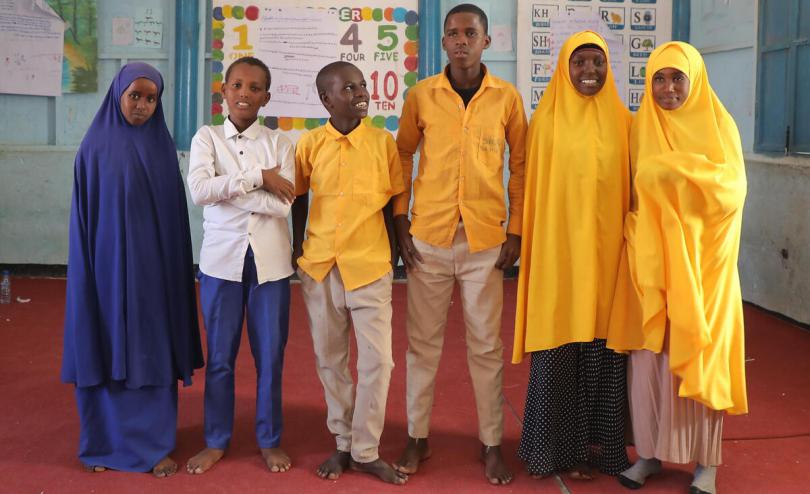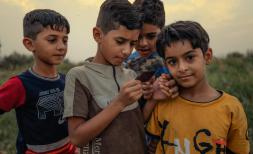GLOBAL GOALS: Two in 5 children starting school won’t be able to read by age 10 unless world leaders take action

- Leaders to meet on 18-19 September for the 2023 Sustainable Development Goals (SDG) Summit in New York.
- The Summit marks the mid-way point towards the 2030 deadline for achieving the goals, and aims to prompt a new wave of high-level political commitment on actions.
UNITED NATIONS, 12 September 2023 – The world is wildly off track to meet the 17 United Nations global goals by 2030, putting the lives and futures of millions of children at risk unless leaders make concrete plans to accelerate progress, Save the Children said as it launched a new data tool to highlight child inequality.
The Sustainable Development Goals (SDGs) – a blueprint of 17 goals agreed by all 193 United Nations (UN) Member States in 2015 to transform our world for the better – have reached their midpoint of implementation, yet barely one in 10 of their requirements are on track to be met by 2030.
Data from the children’s rights agency’s new visualisation tool, the Child Atlas - childatlas.org - shows that 392 million of the 922 million children – or two in every five - starting school over the next seven years will not be able to read and understand a simple text by age 102. With Goal 4 focused on ensuring all children receive a quality education, this statistic reveals how the majority of the world’s children will continue to miss out unless leaders take drastic action to course correct.
Based on current rates of progress, Save the Children’s Child Atlas also projects that over the next 7 years – or the time left for the world to achieve the 17 SDGs -
- 31.6 million of the 942 million babies born between now and 2029 will not survive to celebrate their 5th birthday3.
- Malnutrition will leave more than 1 in 5 babies born stunted4.
- Of the 414 million girls who will finish primary school by 2030, 67 million will marry before turning 185.
- 2.6 billion – or 4 in 5 – children will experience at least one extreme climate event6.
The Child Atlas, launched today, can be used to generate new statistics measuring global progress against several of the goal indicators. The Child Atlas also allows users to explore the different ways inequality affects children’s lives, understand the relationship between different factors, and hear how children describe the problems they are facing.
In light of these devastating findings, Save the Children is urging world leaders meeting at the SDG Summit in New York on 18-19 September to generate renewed commitments supported by concrete plans to accelerate progress toward the SDGs. The agency is calling on leaders to turn promises into action, work both for and with children, and unlock the finance needed to deliver the SDGs and invest in services and systems that put the needs and rights of children first.
Inger Ashing, Save the Children International CEO, said:
“If the Sustainable Development Goals are achieved, the world in 2030 will look markedly different to the one we live in now. There’d be no extreme poverty anywhere, gender equality achieved, inequality reduced, and urgent action taken to combat climate change.
“However, with less than seven years left, children are experiencing multiple, overlapping crises like we’ve never seen before. Hunger, conflict, inequality, poverty and the climate crises threaten children’s survival, protection and right to learn. The SDGs are the best framework we have for charting a way out of this moment of crisis to build a greener, fairer planet for all children.
“Child participation is critical for successfully achieving the SDGs and ultimately children’s rights. It is also a child’s right to have their views heard and participate in public decision-making on issues that affect their lives.
“Data to understand the situation is crucial: it helps policy makers make better decisions and allocate resources effectively. By including disaggregated data on many key indicators, our new Child Atlas includes crucial data to allow world leaders and civil society to better understand why certain groups of children are falling behind, how the intersecting experiences of inequality and discrimination are impacting progress toward the SDGs, and to monitor rates of improvement.”
Save the Children helped shape the SDGs and the accompanying 2030 Agenda, which recognizes children as agents of change. The SDGs were adopted by all UN Member States in 2015 to provide a shared blueprint for peace and prosperity for people and the planet, now and into the future. At their heart was an urgent call for action by all countries - developed and developing - in a global partnership.
Save the Children is also supporting children’s participation and inclusion at the Summit, including a planned “Message in a Bottle” stunt drawing on children’s engagement during the Children’s Week of Action.
NOTES:
[1] The Child Atlas is a new data platform to visualise, compare, analyse and understand children’s outcomes globally. National, subnational, and local data on key child development outcomes across multiple thematic areas are integrated in one publicly available platform, complemented by data on risks and crises, public policies and financing decisions, and other contextual information. The Child Atlas integrates the most recent data from a range of publicly available data sources, including UNICEF, WHO, UNESCO, the World Bank, as well as data curated by civil society organisations and academia.
[2] We project learning poverty (percentage of children at the end-of-primary age who are below minimum reading proficiency adjusted by out-of-school children) based on World Bank data for 122 countries covering both learning deprivation (children who are below minimum reading proficiency) as well as schooling deprivation (out-of-school rates). We also use out-of-school rates from UNESCO for further 53 countries, covering in total ca. 90% of children. To estimate schooling deprivation in the future, we use trend data on children out-of-primary school to calculate the annual rate of reduction observed in the past. Due to data limitations, we do not project changes in the learning deprivation over the next few years and instead use the latest available information for each country (imputing averages based on income level and world regions for countries where this information is missing). We believe this is a reasonable assumption which likely underestimates the real problem, as previous simulation models suggested that learning poverty may sharply increase after the Covid-19 pandemic because of long school closures and ineffective remote learning attempts. We assume that children start primary school at age 6, as this is the most common case across the world. Number of children age 6 between 2023 and 2029 are based on UN Population Prospects 2022.
[3] Under-five mortality (probability of a child dying before they reach their fifth birthday, per 1,000 live births) for 200 countries based on estimates up to 2021 by the UN Inter-agency Group for Child Mortality Estimation (UNICEF/WHO/UN/World Bank). Future trends are calculated using the annual rate of reduction observed in the past. Number of births between 2023 and 2029 are based on UN Population Prospects 2022.
[4] We project stunting (percentage of children under 5 years of age who are too short for their age) based on estimates up to 2022 presented in the Joint Malnutrition Estimates (UNICEF/WHO/ World Bank). The dataset covers 159 countries where 99% of stunting cases take place. Future trends are calculated using the annual rate of reduction observed in the past. As stunting rates are reported as average for children age 0-4 years, we apply projections to each cohort in the year they are expected to reach age 2. Number of children age 0 between 2023 and 2029 are based on UN Population Prospects 2022. This number varies from the number of births due to infant mortality.
[5] We project child marriage (percentage of women aged 20-24 years, married or in union before age 18) based on Save the Children estimates using Demographic Health Surveys and Multi-Indicator Cluster Surveys for 112 countries. We use information for further 28 countries from UNICEF. In total, the dataset captures 140 countries covering the vast majority of child marriages in the world (10.2 million child marriages per year in 2022). Future trends are calculated using the annual rate of reduction observed in the past. For countries where only one data point exists, we use annual rates of reduction observed in other countries in the same income group and world region. Furthermore, as child marriage rates are reported as average for young women age 20-24 years, we use projections for the year the current cohort turns 22. We assume that children finish primary school at age 12, as this is the most common case across the world. Number of children age 12 between 2023 and 2029 are based on UN Population Prospects 2022. We do not account for the fact that some girls may drop out of school before (therefore not finish primary school) or finish at a later age.
[6] We use estimates on extreme climate events produced by BCLIMATE group at the Vrije Universiteit Brussel analysed for Save the Children. They used the largest multi-model climate impact projections database available to date as part of the Inter Sectoral Impact Model Intercomparison Project phase 2b (ISIMIP2b) to estimate the risk of different climate events across the global. The analysis analysed for each grid (using a 0.5 x 0.5-degree resolution, which represents ca. 50x50km on the equator) whether across different models extreme climate events were expected to occur (wildfires, crop failures, droughts, river floods, heatwaves, and tropical cyclones). The data represents the climate risk for 2020 (combining 20 years of projections before and after this year to derive a more robust estimate). The model has been used by Save the Children in previous reports and the estimates were published in the academic journal Science in 2021 (Thiery et al. 2021). We do not project those estimates further, as the 2020 calculations already include some model results up to 2030. This leads to a slight underestimate of extreme climate events, as those are increasing with time. We calculate the number of children living at any time between 2023 and 2029, using the total number of children (0-17 years of age) in 2023 plus any births happening between 2024 and 2029. Total number of children and births are based on UN Population Prospects 2022.
For media enquiries:
- Daphnee Cook Daphnee.cook@savethechildren.org / +254 717 524 904
- Our media out of hours (BST) contact is media@savethechildren.org.uk / +44(0)7831 650409
Please also check our Twitter account @Save_GlobalNews for news alerts, quotes, statements and location Vlogs.




